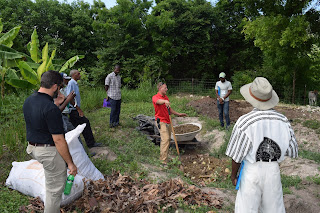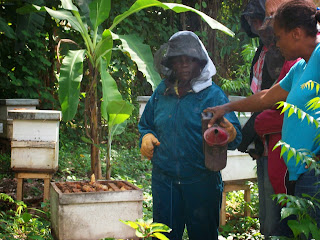June 26 to June 29 2017
La Baleine, Sud, Haiti
On Monday, June 26, Konferans Agrikol Sid opened
with a declaration of gratitude to God for re-growth and renewal after the
devastation of Hurricane Matthew which ravaged southwestern Haiti in October
2016. Conference leaders and delegates, who experienced the destruction and
played significant roles in hurricane response thanked God for regeneration.
This regeneration was evident in the lush countryside, fruit trees weighed down
with mangoes and breadfruit, and the continued drive to increase the resiliency
of small farming systems to such disasters and make food available and abundant
for all through agriculture. The spirit of the conference amongst the 107
attendees was hopeful in the face of real challenges, relating a positive
narrative of Haiti in addition to rallying each person’s commitment to
implement change and apply the knowledge gained at the conference to move Haiti
forward. The chorus of the conference song, which was sung with gusto each
afternoon, boldly stated: “Nou ka travay, nou dwe travay” or “We must work, we
will work.” The week in which all were gathered proved to be a fruitful time in
which agricultural workers connected with one another, learned from each
other’s experience, and shared their knowledge and networks to become
encouraged and equipped with new insight as they continue to work for the
flourishing of their country.
The positive vision of Haiti expressed both by
foreigners and Haitians was a particularly noteworthy aspect of the conference.
Keynote speakers Ricardo Romero and Juan Manuel Martinez Valdez, both hailing
from Mexico, opened their speeches by praising Haiti’s beauty and describing
their good experience in the country as contrary to outside accounts of the
nation which understand Haiti as a place without hope and abounding in poverty
and danger. In sharing about edible food forests, Romero spoke of his encounter
with an impressive, intentionally planted food forest in Jacmel. He also shared
about his visit with SOIL Haiti in Port-au-Prince while championing the
potential of composting toilets and turning human waste into valuable
fertilizer. In this way, Romero identified areas in which people in Haiti were
already practicing what he promoted and in so doing highlighted the strength
and innovation of Haitians and the potential for success in the country.
Additionally, Haitian assets were re-evaluated in meaningful and creative ways.
Breadfruit was presented as a valuable crop worth propagating with high
potential to increase income and feed people. Whereas in the past breadfruit
was considered pig food and the trees were chopped down, representatives from
Trees that Feed Foundation educated delegates regarding the propagation and
processing of this amazing tree that grows abundantly in southern Haiti. The
breadfruit can be dried and ground into flour to supplement income and food in
the home. Dr. Paul Rudenberg, DVM reminded delegates of the assets of farmer
knowledge and experience which can be accessed and appreciated through teaching
and training with participatory methodologies. He emphasized that mutual
learning can occur between “teacher” and “student” when all participants’
knowledge is understood as valuable and participants are invited to share
rather than idly receive outside knowledge deposited by an “expert.”
Innovative solutions to relevant problems and
challenges were also presented at the conference. Caritas presented their work
to alleviate damage caused by the sweet potato weevil, an insect which has
ravaged the Haitian sweet potato crop. They have found two different integrated
pest management techniques to hold promise for reducing the pest problem: 1)
intercropping lantana with sweet potato cuttings to drive off weevil
populations and 2) using a pheromone trap to attract and kill male weevils and
reduce weevil reproduction. There was also widespread interest in an inga-maize
alley cropping system presented by Ricardo Romero that has been practiced for
almost a decade in Honduras and holds potential for producing high yields of
maize in Haiti while simultaneously building the soil and producing fuelwood.
New methods, techniques, and ideas were eagerly received, and people left with
new motivation to creatively respond to problems in their own context.
The entire week of the conference built on the
momentum and movement God has cultivated in Haiti through networks of
missionaries and agriculture workers through the years and more recently in
response to Hurricane Matthew and other challenges. The speakers and
participants expressed their commitment to work break the chain of hunger that
inhibits Haitian development, which is in turn a manifestation of faith in
Christ and the power of Christ in the world. People affirmed that it is God’s
plan for the land to give people food and that this is true for Haiti now.
This Blog was written by Kelly Wilson a ECHO intern.




















































